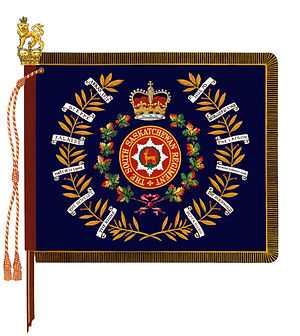The South Saskatchewan Regiment
| The South Saskatchewan Regiment | |
|---|---|
|
The cap badge of the South Saskatchewan Regiment. | |
| Active | Militia July 3, 1905 – September 1, 1968; Supplementary Reserve September 1, 1968 – present |
| Country | Canada |
| Branch | Army, Supplementary Reserve |
| Type | Infantry |
| Size | Nil strength |
| Garrison/HQ | Estevan, Saskatchewan |
| March | "Warwickshire Lads" |
| Battle honours | Arras, 1917; Hill 70; Dieppe; Bourguebus Ridge; St. André sur Orne; Falaise; Falaise Road; The Laison; Forêt de la Londe; Dunkirk, 1944; Antwerp–Turnhout Canal; The Scheldt; Woensdrecht; South Beveland; The Rhineland; The Hochwald; Xanten; The Rhine; Groningen; Oldenburg; North-West Europe 1942, 1944–45. |
The South Saskatchewan Regiment was an infantry regiment of the Canadian Forces formed in 1936 by the amalgamation of The Weyburn Regiment and The Saskatchewan Border Regiment. It was reduced to nil strength and placed on the Supplementary Order of Battle (i.e., virtually disbanded) in 1968. They participated in the 1942 Dieppe Raid.
History
The regiment traces its lineage to July 3, 1905, when an infantry regiment was authorized in the District of Assiniboia and the District of Saskatchewan, which later that year became the province of Saskatchewan. The regiment was eventually organized as the 95th Saskatchewan Rifles, in Regina. After the First World War the 95th merged with the 60th Rifles of Canada (in Moose Jaw) to become the South Saskatchewan Regiment, which expanded to five battalions with the creation of units in Weyburn (3rd Battalion), Moosomin (4th Battalion) and Estevan (5th Battalion).
In 1924, each of the battalions became a distinct regiment, and the name "South Saskatchewan Regiment" went out of use. In the 1936 reorganization of the Militia, the Weyburn Regiment and the Saskatchewan Border Regiment (in Estevan) re-amalgamated into a new South Saskatchewan Regiment.
During the Second World War, The South Saskatchewan Regiment participated in many major Canadian battles and operations, as part of the 2nd Canadian Infantry Division. The South Saskatchewan Regiment was a major combatant in the Dieppe Raid of 1942, Operation Atlantic, Operation Spring, Operation Totalize, Operation Tractable, and the recapture of Dieppe in 1944. They, along with the 8th Reconnaissance Regiment liberated the Westerbork transit camp on 12 April 1945.
Lineage of the South Saskatchewan Regiment:[1]
| Lineage | ||||||||||||||||||||||||||||||||||||||||||||||||||||||||||||||||||||||||||||||||||||||||||||||||||||||||||||||||||||||||||||||||||||||||||||||||||||||||||||||||||||||||||||||||||||||||||||||||||||||||||||||||||||||||||||||||||||||||||||||||||||||||||||||||||||||||||||||||||||||||||||||||||||||||||||||||||||||||||||||||||||||||||||||||||||||||||||||||||||||||||||||||||||||||||||||||||||||||||||||||||||||||||||||||||||||||||||||||||||||||||||||||||||||||||||||||||||||||||||||||||||||||||||||||||||||||||||||||||||||||||||||||||||||||||||||||||||||||||||||||||||||||||||||||||||||||||||||||||||||||||||||||||||||||||||||||||||||||||||||||||||||||||||||||||||||||||||||||||||||||||||||||||||||||||||||||||||||||||||||||||||
|---|---|---|---|---|---|---|---|---|---|---|---|---|---|---|---|---|---|---|---|---|---|---|---|---|---|---|---|---|---|---|---|---|---|---|---|---|---|---|---|---|---|---|---|---|---|---|---|---|---|---|---|---|---|---|---|---|---|---|---|---|---|---|---|---|---|---|---|---|---|---|---|---|---|---|---|---|---|---|---|---|---|---|---|---|---|---|---|---|---|---|---|---|---|---|---|---|---|---|---|---|---|---|---|---|---|---|---|---|---|---|---|---|---|---|---|---|---|---|---|---|---|---|---|---|---|---|---|---|---|---|---|---|---|---|---|---|---|---|---|---|---|---|---|---|---|---|---|---|---|---|---|---|---|---|---|---|---|---|---|---|---|---|---|---|---|---|---|---|---|---|---|---|---|---|---|---|---|---|---|---|---|---|---|---|---|---|---|---|---|---|---|---|---|---|---|---|---|---|---|---|---|---|---|---|---|---|---|---|---|---|---|---|---|---|---|---|---|---|---|---|---|---|---|---|---|---|---|---|---|---|---|---|---|---|---|---|---|---|---|---|---|---|---|---|---|---|---|---|---|---|---|---|---|---|---|---|---|---|---|---|---|---|---|---|---|---|---|---|---|---|---|---|---|---|---|---|---|---|---|---|---|---|---|---|---|---|---|---|---|---|---|---|---|---|---|---|---|---|---|---|---|---|---|---|---|---|---|---|---|---|---|---|---|---|---|---|---|---|---|---|---|---|---|---|---|---|---|---|---|---|---|---|---|---|---|---|---|---|---|---|---|---|---|---|---|---|---|---|---|---|---|---|---|---|---|---|---|---|---|---|---|---|---|---|---|---|---|---|---|---|---|---|---|---|---|---|---|---|---|---|---|---|---|---|---|---|---|---|---|---|---|---|---|---|---|---|---|---|---|---|---|---|---|---|---|---|---|---|---|---|---|---|---|---|---|---|---|---|---|---|---|---|---|---|---|---|---|---|---|---|---|---|---|---|---|---|---|---|---|---|---|---|---|---|---|---|---|---|---|---|---|---|---|---|---|---|---|---|---|---|---|---|---|---|---|---|---|---|---|---|---|---|---|---|---|---|---|---|---|---|---|---|---|---|---|---|---|---|---|---|---|---|---|---|---|---|---|---|---|---|---|---|---|---|---|---|---|---|---|---|---|---|---|---|---|---|---|---|---|---|---|---|---|---|---|---|---|---|---|---|---|---|---|---|---|---|---|---|---|---|---|---|---|---|---|---|---|---|---|---|---|---|---|---|---|---|---|---|---|---|---|---|---|---|---|---|---|---|---|---|---|---|---|---|---|---|---|---|---|---|---|---|---|---|---|---|---|---|---|---|---|---|---|---|---|---|---|---|---|---|---|---|---|---|---|---|---|---|---|---|---|---|---|---|---|---|---|---|---|---|---|---|---|---|---|---|---|---|---|---|---|---|---|---|---|---|---|---|---|---|---|---|---|---|---|---|---|---|---|---|---|---|---|---|---|---|---|---|---|---|---|---|---|---|---|---|---|---|---|---|---|---|---|---|---|---|---|---|---|---|---|---|---|---|---|---|---|---|---|---|---|---|---|---|---|---|---|---|---|---|---|---|---|---|---|---|---|---|---|---|---|---|---|---|---|---|---|---|---|---|---|---|---|---|
| ||||||||||||||||||||||||||||||||||||||||||||||||||||||||||||||||||||||||||||||||||||||||||||||||||||||||||||||||||||||||||||||||||||||||||||||||||||||||||||||||||||||||||||||||||||||||||||||||||||||||||||||||||||||||||||||||||||||||||||||||||||||||||||||||||||||||||||||||||||||||||||||||||||||||||||||||||||||||||||||||||||||||||||||||||||||||||||||||||||||||||||||||||||||||||||||||||||||||||||||||||||||||||||||||||||||||||||||||||||||||||||||||||||||||||||||||||||||||||||||||||||||||||||||||||||||||||||||||||||||||||||||||||||||||||||||||||||||||||||||||||||||||||||||||||||||||||||||||||||||||||||||||||||||||||||||||||||||||||||||||||||||||||||||||||||||||||||||||||||||||||||||||||||||||||||||||||||||||||||||||||||
Perpetuations
Battle honours

Battle honours in small capitals are for large operations and campaigns and those in lowercase are for more specific battles. Bold type indicates honours authorized to be emblazoned on the regimental colour.
First World War
Second World War
- Dieppe
- Bourguébus Ridge
- St. André sur Orne
- Falaise
- Falaise Road
- The Laison
- Forêt de la Londe
- Dunkirk, 1944
- Antwerp–Turnhout Canal
- The Scheldt
- Woensdrecht
- South Beveland
- The Rhineland
- The Hochwald
- Xanten
- The Rhine
- Groningen
- Oldenburg
- North-West Europe 1942, 1944–45
Alliances
The regiment was formerly allied with these regiments, but these alliances automatically expired when the British regiments amalgamated with other regiments.
-
 The Royal Warwickshire Fusiliers
The Royal Warwickshire Fusiliers -
 The King's Own Royal Border Regiment.
The King's Own Royal Border Regiment.
Notable members
- Joseph Gregory
- Charles Cecil Ingersoll Merritt VC
Music
"We're the boys of the S.S.R." words by Isabel McCrae Parker and music by Arthur Clare Parker was published in Weyburn, Saskatchewan by A.C. Parker, circa 1939 was dedicated to the officers and men of the South Saskatchewan Regiment. First line: "We're the boys who have gathered from near and far".[4]
Media
- The March of the Prairie Men: A Story of the South Saskatchewan Regiment by Lt. Col. G. B. Buchanan (1900)
References
- ↑ "The South Saskatchewan Regiment". Official Lineages: Volume 3: Combat Arms Regiments, Part 2: Infantry Regiments. Directorate of History and Heritage. October 2010. Retrieved October 13, 2011.
- ↑ "Perpetuation of C.E.F. Units – Infantry – 151st Bn to 200th Bn". Retrieved November 25, 2007.
- ↑ Canadian Forces Publication A-DH-267-003 Insignia and Lineages of the Canadian Forces. Volume 3: Combat Arms Regiments.
- ↑ "We're the boys of the S.S.R.". Retrieved January 9, 2012.
| ||||||||||||||||||||||||||||||||||||||
